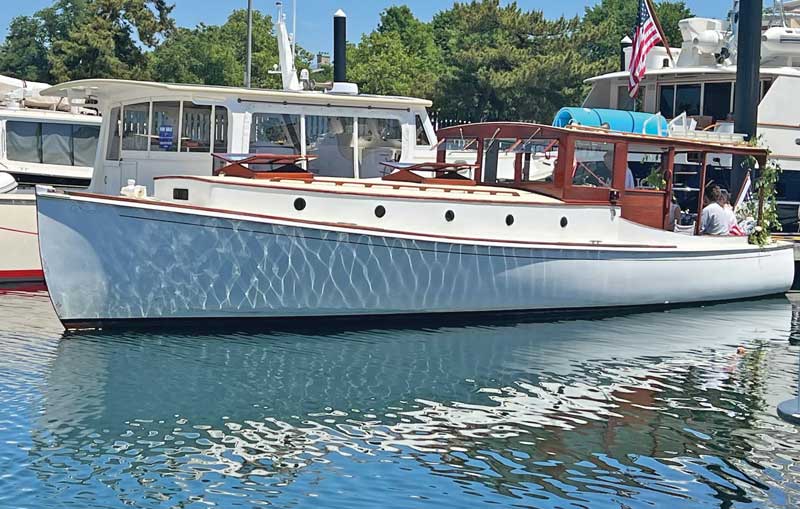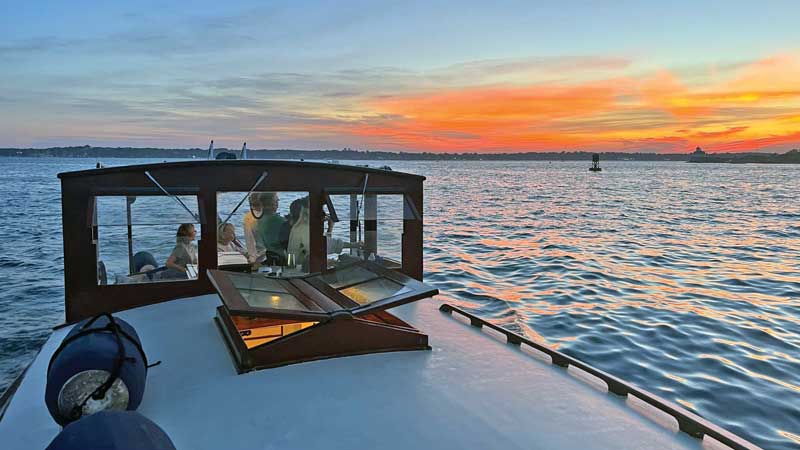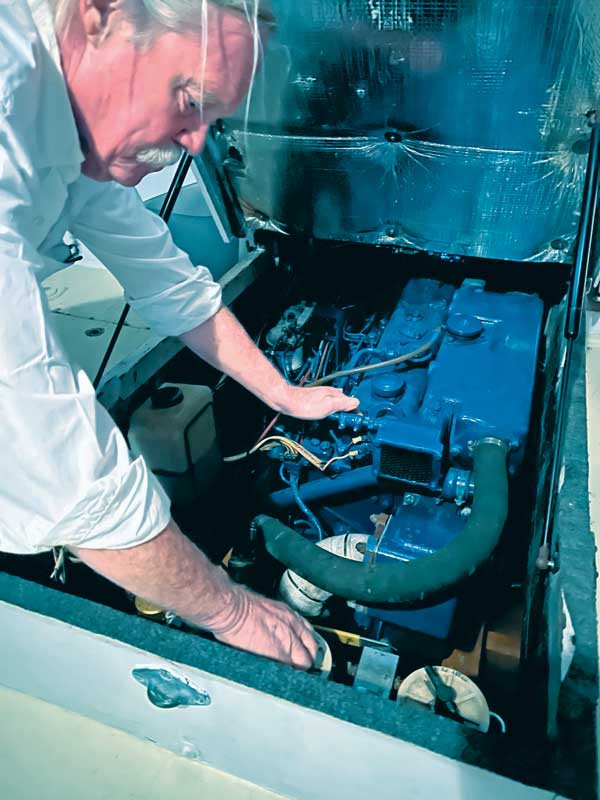Grandfather once told me, in reference to preparing a boat for the winter, that whatever you do right in the fall, when putting her away, you won’t have to repair in the spring. Springtime is, after all, when we find out just what we did wrong in the fall.

I learned this lesson one year when I neglected to properly drain my freshwater system. The water froze in the lines over the winter and, even though the lines were made of what I considered to be a somewhat flexible material, they split nonetheless and, in the spring, when I engaged the pressure pump, there were leaks (some quite dramatic) everywhere. I had a lot of hose to replace, some of it in very inaccessible places, which resulted in a bit of strong language, mostly self-directed. Since then, I drain and pickle my freshwater lines every fall, whether I am expecting a harsh winter or a mild one, and flush them liberally in the spring at commissioning time. As Ben Franklin once wrote, “Experience keeps a dear school, but only fools will learn in it.” Ben, as we learn, actually spent a great deal of time in boats, primarily in crisscrossing the Atlantic, so he ought to know something.
It’s fall, now. Winters in the Chesapeake region are not significantly different climactically from those in southern New England, where I hail from, and thus methods of winterization do not and should not vary significantly either. In many cases, marinas and boatyards with their teams of professional mechanics and boat systems specialists will handle various vessel winterization procedures for their clients, when contracted to do so. But there are also many more of us who are D.I.Y. boat owners and who always have been (and probably always will be), so there are a number of winterization tasks that must be performed every year, done the same way, and with the same level of detail. It is perfectly sensible to leave engine winterization and cylinder-fogging, for example, to the yard’s professional mechanic. These folks know what they are doing, they do it all the time, and they can often spot other things that may be out of order and bring them to your attention, problems that you might not notice. They are well worth the money spent.

Cold and freezing are the enemies of the boat owner, and it follows that so also is moisture, seeping into decks around hardware and fittings, for example, and then freezing and causing delamination, rot, and a host of other issues over the idle winter months. Investing in a moisture meter, an instrument that can sense moisture below the surface of the deck, is therefore money well spent.
Powerboat Winterization
Among the DO’s and DON’Ts of winterization, some of these line items fall under the category of the familiar, the common-sense, and there are the not-so-familiar items, but here are a few key things to remember:
- Change engine oil and sterndrive or lower unit oil before laying up. This prevents acidic used oil from damaging internal parts.
- Fog gasoline engines to protect against internal rust. I also fogged my auxiliary diesel engines as well. After all, a piston is a piston, and steel against steel is a good way to freeze up an engine if condensation forms in the cylinder and rusts things together. When I was a lad, I recall Grandfather having to pull the cylinder head off the old Chrysler Crown engine every couple of years after a particularly harsh winter and put a chock of wood in the bore with oil and smack away at it with a big wooden hammer to free up the pistons. Every hammer blow rang like a bell that could be heard floating across the springtime air at the boatyard.
- Fill gasoline tanks and treat the fuel with stabilizer, or completely drain to ward off ethanol-induced issues and stale gas the following spring. E10 fuel is a particular culprit. Generally, I have heard friends say that ethanol-infused gasoline is fresh for perhaps three weeks and no more. Bad fuel makes for a sick engine.
- Flush outboards with freshwater and store in their lowest position to prevent water from remaining inside and freezing. Let ‘er drain!
- Remove expensive electronics and fishing gear, and store at home to prevent damage or theft over the winter. Freezing is never good for any electronic device with a display. Should moisture work its way in over the summer, if it freezes, it can harm the display unit.
- Don’t use an electric heater. It will be very expensive to run and won’t make any appreciable difference anyway. Your heater can’t put out enough heat to make any difference. I learned this the hard and costly way one year. A boating fellow told me that, “The only real way to warm up the boat in the wintertime is to sail it to warmer waters.” Amen to that. If you can’t do that, put her up on the hard, charge her batteries, drain and pickle everything else, and don’t worry about her. I have known boatyard owners to fly into a frothing rage to find live extension cords in winter leading to boats that had a space heater running inside, or a battery charger, with no owner anywhere around. For some reason (vibration?), space heaters tend to move around and tip over. More boatyard fires have begun, and multiple boats destroyed, by electric space heaters carelessly or deliberately left running by an inconsiderate blockhead (wooden, double-ash block) of a boat owner.
- Visit your boat from time to time to check for such things amiss as loose jack stands, slack or slapping rigging, water pooling, loose tarp straps, anything dripping or leaking or not looking right. Look carefully, walk around the boat like pilots do their plane before a flight. Problems are not always obvious at first. Take your time.
Outboard Engines
If the engine is small enough, like a dinghy engine, it makes sense to remove it, or arrange to have it serviced by your favorite marina. It’s rarely cheap, but can you put a price on peace of mind? My venerable 9.9 two-stroke Yamaha dinghy motor, after its annual winterizing and fogging at my local boatshop, spends the rest of the winter upright in my backyard tool shed where it is dry and out of the weather. During the worst Covid year, it saw almost no use, so I simply ran it in freshwater, drained it, and fogged the cylinders with over the shelf fogger and returned it to its shed. But any year that it sees any appreciable use, it goes to the engine shop. It’s not about saving money, really. Any money saved through skimping on maintenance is truly false economy.

Customize Your List
The best way to begin is to make a list, or use someone else’s comprehensive list, and customize it to suit your own requirements. One size does not fit all, and yet if you rely on your own ideas only, you will probably miss something. There are many winterization guides out there, and one of the best is offered by BoatUS. Simply Google “The Boater’s Guide to Winterizing” and you’ll have everything you need to know to comprehensively winterize your power (or sail) boat and systems.
Winterizing TEMMA, a 42-foot Raised Cabin Picnic Yacht Built in 1928
It stands to reason that the more a boat is used in-season, the more comprehensive the end of season winterization process should be. That way, come spring, she’s mostly ready. If your boat is a hard-working boat driving tourists around a waterway, and on top of that is nearly 100 years old, then winterization is an extra-detailed job. TEMMA, a wooden 42-foot motoryacht built in Boothbay, ME, in 1928, is powered by a Perkins 632 diesel and gets extra care from her skipper, Capt. Tom Bradford. Such procedures as changing her fuel filters, sea strainer, and tending to her many needs and quirks keeps that classic running all season and set up to survive the cold winters without worry. “You absolutely have to make a good list specific to the boat,” Bradford says, “And don’t ignore a single detail. Also make sure that scheduled maintenance procedures are done correctly and at their listed times.”
Many thanks to Capt. Tom Bradford and Ken Hudson of the classic 1928 Motor yacht TEMMA. TEMMA takes sightseers around Newport, RI, Harbor and other local waters every summer. For more information, visit Newportclassicyachtco.com or email [email protected].
By Capt. Michael L. Martel